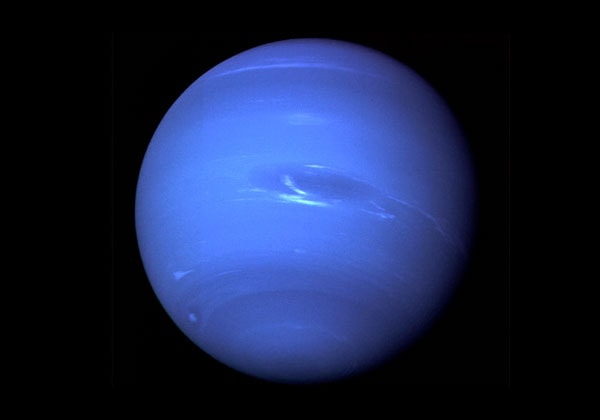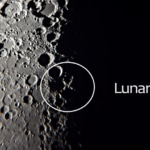Nebulous Neptune
Neptune is the eighth, and farthest, planet in our Solar System. Learn more about the mysterious "Blue Planet."

Neptune is the eighth, and farthest, planet in our Solar System, and the first whose existence was theorized before its actual discovery. Learn more about the mysterious “Blue Planet.”
– Neptune was first spotted by Italian astronomer Galileo Galilei on December 28, 1612. Because Galileo mistook the planet for a star, however, he is not credited with its discovery. The planet was rediscovered on September 23, 1846, by Johann Galle. Three years prior to this, however, mathematicians Urbain Le Verrier and John Couch Adams hypothesized that changes in the orbit of Uranus were caused by a an undiscovered eighth planet. They calculated coordinates for their hypothetical planet, placing it very near the coordinates where Neptune was later found.
– Like Jupiter, Saturn, and Uranus, Neptune is called a “gas giant” because, though it looks solid, it is made up primarily of gases, such as hydrogen and helium, covering a rocky core comprised of heavier elements. Neptune and Uranus are also often referred to as “ice giants,” though, because their chemical composition differs somewhat from the two larger gas giants. Uranus and Neptune both contain more ice in their atmosphere, formed from compounds such as water, ammonia, methane, and hydrocarbons, than Jupiter or Saturn.
– At a diameter of 30,775 miles at its equator, Neptune is the fourth-largest planet in the Solar System, and the third largest by mass. Though it is smaller in size than its neighbor and near twin, Uranus, Neptune is denser and slightly heavier. Its mass is 17 times that of Earth, while Uranus’ mass is 15 times that of Earth.
– It takes Neptune nearly 165 years to orbit the Sun, making each of the planet’s seasons last more than 40 years. Because Neptune’s surface is gaseous, different portions of the planet rotate at different rates. Its equator rotates about once every 18 hours, while its poles complete a rotation in about 12 hours.
– Neptune has 13 known moons: Triton, Proteus, Naiad, Thalassa, Despina, Galatea, Larissa, Nereid, Halimede, Sao, Laomedeia, Psamathe, and Neso. Each is named after a minor Greek water god. The largest, Triton, makes up more than 99% of the mass of all of the planet’s moons combined. It was the first to be discovered, 17 days after Neptune, itself, was found, and remained unnamed until the 20th Century. The remaining 12 moons have all been discovered since 1981, and are all small and irregularly shaped.
– Neptune is named after the Roman god of the sea, known as Poseidon to the Greeks. For a few months after its discovery, the planet was known as either “the planet exterior to Uranus” or “Le Verrier’s planet.” Le Verrier proposed the name Neptune, in keeping with the tradition of naming all of the planets, except Earth, after a mythological figure. He later recanted, asking that the planet be named after himself, but his original suggestion was the one that stuck.
– Neptune is the second coldest planet in the solar system, after Uranus, with an average surface temperature of -328º F, and a low of about -360º F. Currently, its South Pole, which has been facing the Sun for the last 40 years, is about 10º warmer than the rest of the planet. As the seasons shift, the planet’s North Pole will warm up. Though it is much further from the sun than Uranus — one and a half times farther, in fact — it is a hair warmer than Uranus. That’s because chemical reactions inside the planet cause it to generate some of its own heat.
– Neptune’s atmosphere is home to the strongest and fastest winds in our solar system, with speeds up to 1,200 miles per hour! Like Jupiter, the planet features many “spots,” created by violent storms raging on its surface. These storms can last for many years or decades. The largest, dubbed “the Great Dark Spot” is the size of the Earth. A smaller storm, known as “Scooter” rings the entire circumference of the planet every 16 hours.
– Neptune has four narrow, faint rings made up of dust particles. Astronomers believe these rings were created by tiny meteorites that smashed into Neptune’s moons.
– Neptune can’t be seen with the naked eye, so get your hands on a good telescope or high-powered binoculars and a current star chart. The planet is bright enough that, with a high-powered telescope, you should be able to see its blue tint. As of the end of 2010, it can be found near the constellation Aquarius.

Jaime McLeod
Jaime McLeod is a longtime journalist who has written for a wide variety of newspapers, magazines, and websites, including MTV.com. She enjoys the outdoors, growing and eating organic food, and is interested in all aspects of natural wellness.





